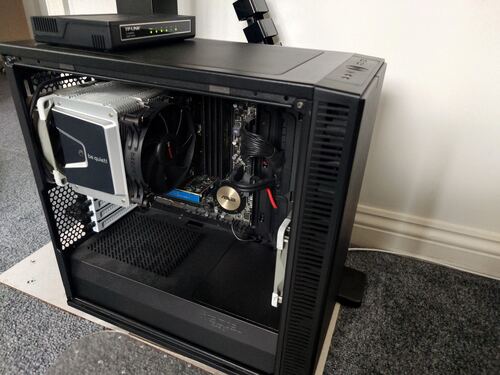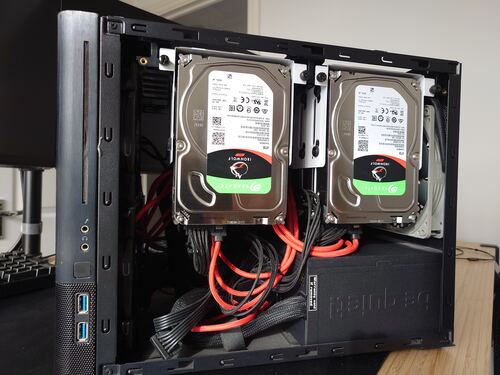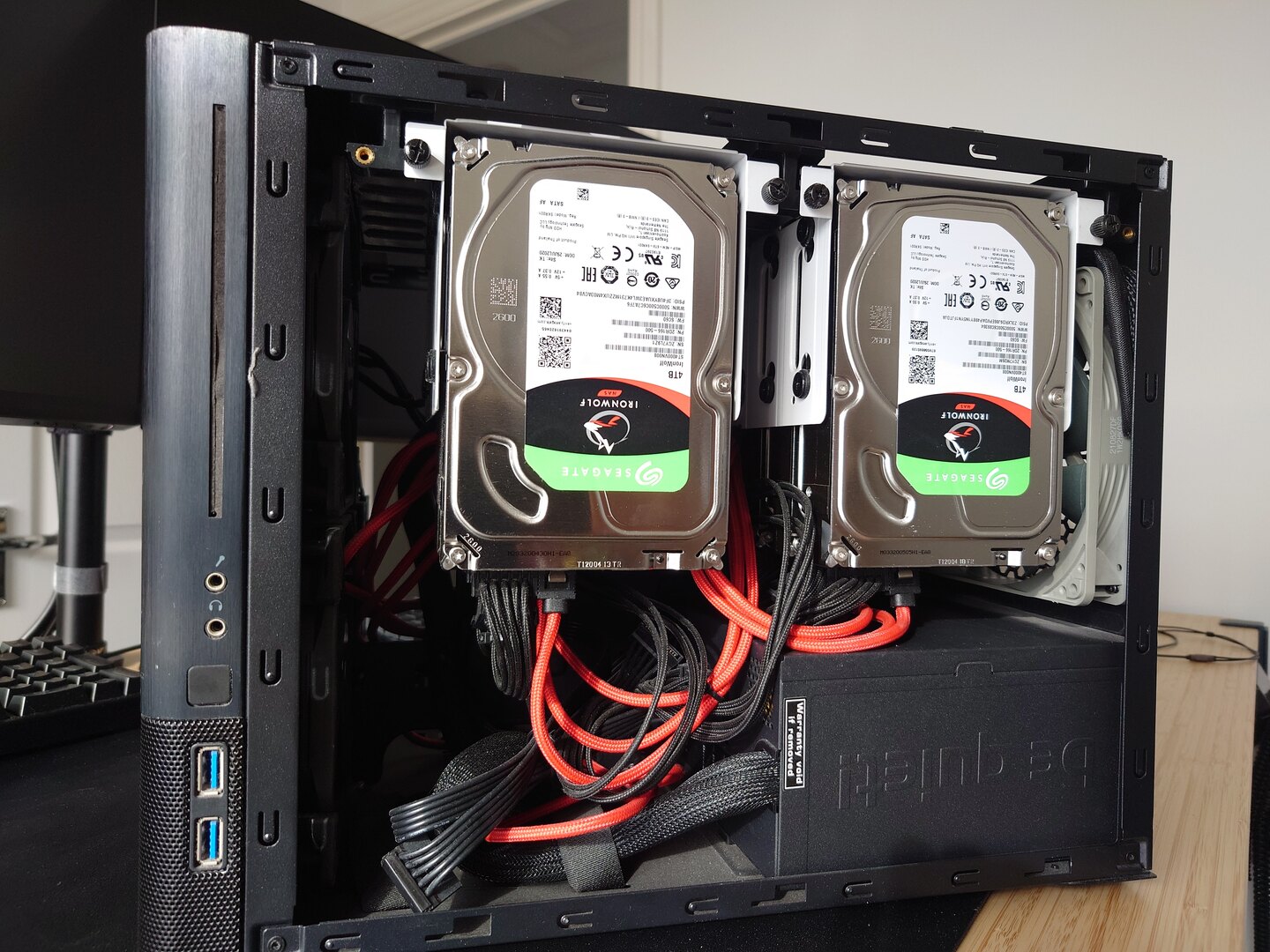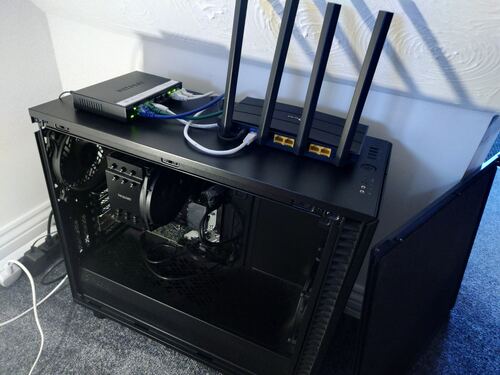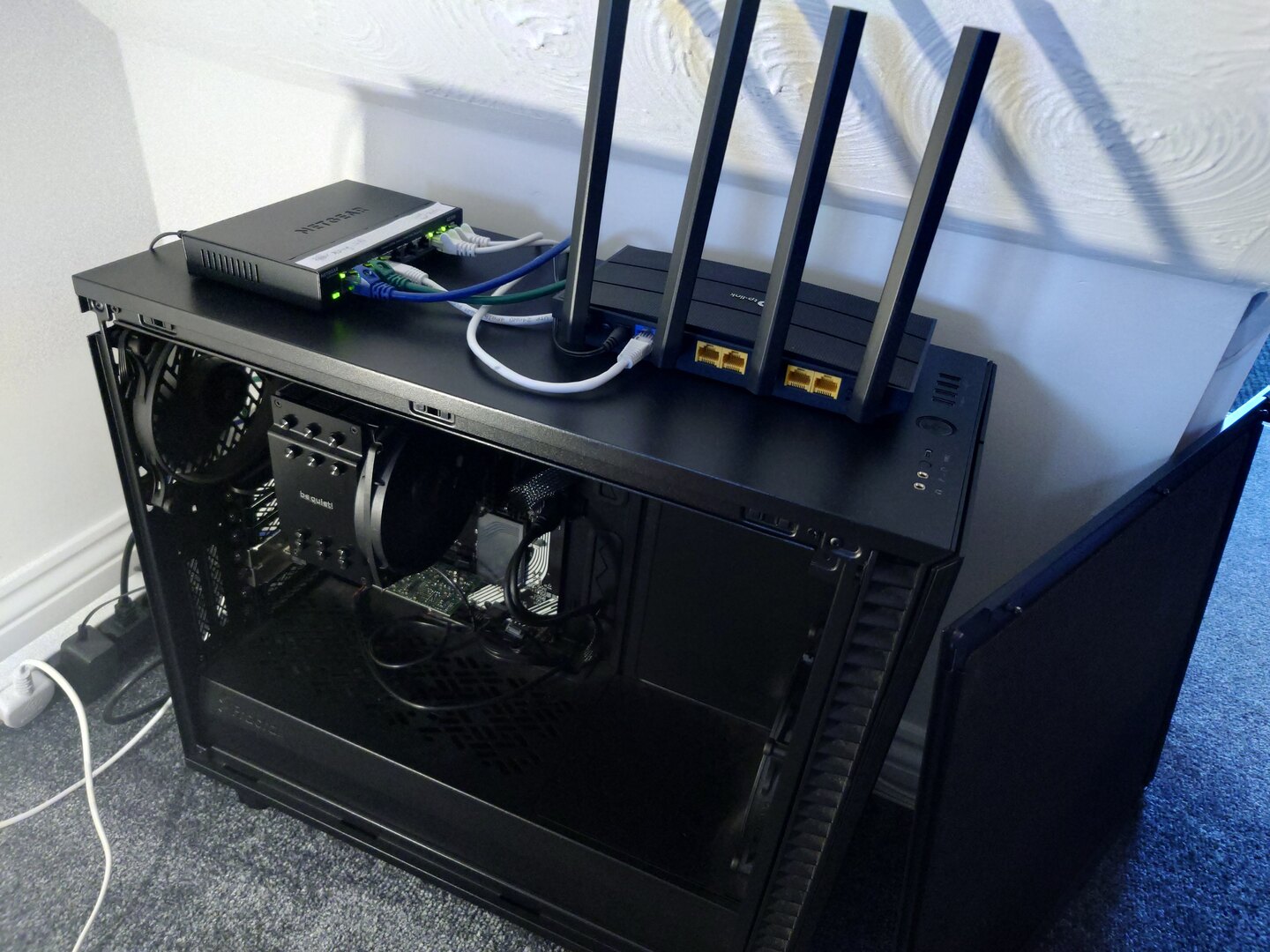It’s been about eight years since I started running network services in my home. It all started with Pi-hole, which I ran not on a Raspberry Pi, but an Atom-powered Dell Mini “thin client” I acquired from eBay. Today I run a lot more and it’s become what is now known as a Homelab.
I’m quite fond of it all, so thought I might as well write about it.
NAS
I built my NAS around five years ago. At the time my PC was in a Fractal Design Node 804 case, but I decided this was much more suitable for use as a NAS, so I transplanted my PC into a smaller case and used the Node for my NAS. The specs are as follows:
- Asus WS C246M Pro motherboard,
- Intel Core i3 9100 3.6 GHz CPU,
- 32 GiB ECC memory,
- 6x4 TiB Seagate Ironwolf HDDs.
I went for the i3 because, unlike the i5 or i7, it supports ECC memory. To get higher performance it would be necessary to go Xeon, but it’s a NAS so I didn’t plan to do much computation. The motherboard is a workstation board; I can’t really remember why I went for it but I think I wanted something between a “real” server board and a desktop board and this was a good price.
For the operating system I chose TrueNAS (then FreeNAS). I’m still on TrueNAS Core (FreeBSD based). It’s been absolutely rock solid. I’m so glad I went with a custom NAS rather than something off the shelf like Synology (especially considering recent events).
I opted for a RAIDZ2 pool which means I can lose up to two disks before I lose any data. So far, I haven’t lost any, but as the disks are all five years old now I am considering the possibility.
I since added an SSD which I use for higher performance, but less critical data, like databases that are backed up elsewhere.
At first I ran VMs on this box, but now I have my dedicated XCP-ng box I don’t run any.
XCP-ng
I acquired a PC and decided to install XCP-ng on it. It started off as me just wanting to play around with Kubernetes so I made a few VMs and created a cluster. But now this box hosts real services.
I didn’t build the PC so I’m not 100% on the specs, but it has a Intel Core i5 10600K 4.1 GHz 6 core/12 thread CPU and 32 GiB of RAM. I’ve added an Intel 4 port gigabit Ethernet card and a USB card, both of which I pass through to VMs.
The most important VM I run is my OPNsense router. This is my internet gateway, DHCP server, DNS server and more. I run my router on here out of necessity. Previously I ran pfSense on the aforementioned Dell Mini PC, but I since got a gigabit internet connection, and the poor thing wasn’t able to route above about 300 Mbit/s. I could have bought a completely separate router that could handle the speeds but, being a cheapskate, I opted for a used quad Ethernet card instead.
I did think it was a bit crazy running my router as a VM, but I’ve been running it this way for over a year and it’s been fine. The only trouble I have is with it sometimes not picking up the connection to my modem when it boots. Sometimes I have to reboot the entire hypervisor for it to work, which is annoying.
I run an Ubuntu server which does two main things: hosts my USB printer and my Forgejo
git server. XCP-ng supports USB passthrough, but I found it did not persist following VM
reboots, so instead I bought a cheap PCI USB card and pass through the card instead and
this works perfectly. I have an old Samsung laser printer that still works fine after 15
years and Ubuntu still includes the drivers in the printer-driver-splix package.
Four of the VMs are Kubernetes nodes. Yes, it’s wasteful to run 4 VMs on one physical box, but this is a Homelab after all. I also run Xen Orchestra for managing XCP-ng.
Networking
My networking is wired wherever possible. I believe in wireless only for portable devices. If something stays put, I make an effort to wire it in. I use a couple of Netgear unmanaged switches, nothing fancy. For WiFi I use a TP-Link access point.
I run a local Unbound DNS server on OPNsense which is a full recursive resolver using
the root name servers. I have blocklists included here, similar to Pi-Hole. I use
Unbound to also give my local services names. I’m using a lot of wildcard DNS to make
things simple (for example a wildcard that resolves and *.k8s.lab to my Kubernetes
cluster).
I work from home so I have a redundant internet connection via a data-only 4G plan and a 4G modem. This is configured as a fallback connection in OPNsense and traffic gets routed there if/when my main connection goes down.
I don’t have anything available publicly and instead use Wireguard to get access when I’m out of the house. As my IP address is dynamic I use a Dynamic DNS client to configure my domain name when my IP address changes.
Kubernetes
I run most of my services using Kubernetes these days. Initially I used Docker Compose, which is great, but I no longer think it’s suitable for running a lot of services. I do use it extensively for development, of course.
My cluster is running Talos which has been great. It’s a bare metal Kubernetes immutable distro which I wrote about here.
I’m using Flux to configure my cluster. This has also been great. Flux support the “GitOps” approach wherein you just make changes in a git repo and they are automatically rolled out to provision infrastructure etc. This is why I don’t run Forgejo on the k8s cluster as otherwise it would be a circular dependency!
Apps I’m currently running include:
- Kubernetes dashboard,
- Freetar,
- Immich,
- Invidious,
- Jellyfin,
- Metube,
- Owntone,
- Speedtest,
- Tandoor,
- TheLounge,
- TubeSync.
I’m also running a monitoring stack using kube-prometheus-stack with Grafana dashboards.
Many of these apps uses databases which I provision using CloudNativePG. This lets me declaratively create databases and even automatically back them up to S3 compatible buckets.
Conclusion
My homelab is part hobby, part training ground, and part real self-hosting of my digital life. Many things I do just for fun and are obviously enormous overkill. Others I do for learning or trying things out and eventually use them for real in my day job. Increasingly I’m using it to escape “cloud” providers, in particular Google, and take control of my own data.
One thing I will have to bear in mind is I might not always want to put this much effort in to everything. I’m on top of the K8s stuff now because it’s what I do at work too, but that might not always be the case. The good thing about self-hosting is I’m not locked into anything, though. If I want a more turnkey solution later, like TrueNAS Scale, for example, then I should be able to migrate easily.
But for now I’m enjoying it even if some of it is ridiculous overkill.
